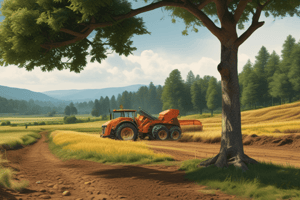Podcast
Questions and Answers
What percentage of the final grade is allocated to labs?
What percentage of the final grade is allocated to labs?
- 60%
- 50%
- 40% (correct)
- 30%
What is the consequence of not meeting the required passing grade?
What is the consequence of not meeting the required passing grade?
- Get a grade of 'D'
- Be allowed to retake the course
- Earn an 'F' grade (correct)
- Receive an incomplete grade
What happens if an assignment is submitted late?
What happens if an assignment is submitted late?
- A 10% deduction is applied per day (correct)
- A zero is given immediately
- No penalty is applied
- The assignment is simply rejected
Which item is NOT included in the course outline?
Which item is NOT included in the course outline?
What is the required action if a student misses an evaluation due to illness?
What is the required action if a student misses an evaluation due to illness?
What could potentially lead to an error in maintaining the desired temperature?
What could potentially lead to an error in maintaining the desired temperature?
In a feedback control system, what is the role of the controller?
In a feedback control system, what is the role of the controller?
Which component is responsible for modifying the process in a feedback control system?
Which component is responsible for modifying the process in a feedback control system?
What is meant by 'disturbance' in the context of process control?
What is meant by 'disturbance' in the context of process control?
In the context of a heat exchanger, what is the desired outcome of the process?
In the context of a heat exchanger, what is the desired outcome of the process?
What is the main focus of Week 5 in the course schedule?
What is the main focus of Week 5 in the course schedule?
Which lab assignment is associated with the Midterm Exam?
Which lab assignment is associated with the Midterm Exam?
Which of the following topics is introduced in Week 8?
Which of the following topics is introduced in Week 8?
What are the two sections for lab hours in the course schedule?
What are the two sections for lab hours in the course schedule?
Which control method is taught during Week 6?
Which control method is taught during Week 6?
What type of systems are classified based on what they control?
What type of systems are classified based on what they control?
Which week covers Programming Timers for an on delay and off delay?
Which week covers Programming Timers for an on delay and off delay?
In which week of the course does reading week occur?
In which week of the course does reading week occur?
What does the response time of a sensor indicate?
What does the response time of a sensor indicate?
Which characteristic indicates how closely the sensor output follows a straight line?
Which characteristic indicates how closely the sensor output follows a straight line?
Which of the following denotes the smallest measurement a sensor can effectively detect?
Which of the following denotes the smallest measurement a sensor can effectively detect?
What is the definition of precision in sensor characteristics?
What is the definition of precision in sensor characteristics?
Which of these is NOT a standard electronic signal used by transmitters?
Which of these is NOT a standard electronic signal used by transmitters?
What does accuracy in sensor measurements refer to?
What does accuracy in sensor measurements refer to?
Which statement about transducers and transmitters is true?
Which statement about transducers and transmitters is true?
Hysteresis in sensor characteristics refers to what phenomenon?
Hysteresis in sensor characteristics refers to what phenomenon?
What does the letter 'F' represent in the functional identifier of a P&ID?
What does the letter 'F' represent in the functional identifier of a P&ID?
Which of the following symbols is represented by the first ID letter 'R' in a P&ID?
Which of the following symbols is represented by the first ID letter 'R' in a P&ID?
What does a dashed horizontal line indicate in a P&ID?
What does a dashed horizontal line indicate in a P&ID?
In a P&ID, which of the following instrument line symbols represents an Indicator?
In a P&ID, which of the following instrument line symbols represents an Indicator?
What type of connection is indicated by the letter 'C' in the identification scheme of P&ID?
What type of connection is indicated by the letter 'C' in the identification scheme of P&ID?
Which of the following is NOT a representation of a pneumatic signal in a P&ID?
Which of the following is NOT a representation of a pneumatic signal in a P&ID?
What does the letter 'T' signify when used in conjunction with 'Transmitter' in a P&ID?
What does the letter 'T' signify when used in conjunction with 'Transmitter' in a P&ID?
Which of the following represents a software or data link in P&ID symbols?
Which of the following represents a software or data link in P&ID symbols?
Flashcards are hidden until you start studying
Study Notes
Sensor Characteristics
- Sensors do not respond instantly to changes in measured variables.
- Response time is the duration it takes for a sensor to react to a change.
- Flow and pressure sensors respond faster than temperature sensors.
Static Characteristics of Sensors
- Sensitivity: output change in response to input change, measured as the slope of the Input/Output (I/O) curve in linear devices.
- Hysteresis: Different output values for increasing or decreasing inputs.
- Resolution: Smallest measurable value by the sensor.
- Linearity: Closeness of the I/O relationship to a straight line.
- Accuracy: Measured value's closeness to the actual controlled variable value, meeting acceptable tolerances.
- Precision: Consistent response to the same input value, also known as "repeatability".
Transducers and Transmitters
- Transducers convert a sensor's signal to a different physical form, while Transmitters amplify the signal and convert it to a standard signal.
- Standard instrumentation signals:
- Pneumatic: 3 – 15 psi
- Electronic: 0 – 10VDC, 0 - 20 mA DC, 4 – 20 mA DC.
- Current signals are preferred over voltage signals as they are independent of wire resistance
Control Systems - ENGI 24495
- Process & motion control: Industrial control systems are classified by what they control.
- Open-loop & closed-loop control: Two main types of control systems.
- Feedback & feedforward control: Techniques used in closed-loop control.
- Instrumentation: The use of measuring devices and sensors.
- Piping & Instrumentation Diagram (P&ID): Visual representation of process systems, including piping and instrumentation.
Administration
- Lecturer: Ahmed Hosny, Ph.D.
- Textbook: Terry Bartelt, Industrial Automated Systems: Instrumentation and Motion Control, Cengage Learning, 2011.
- Assignments:
- Labs (8 @ 5% each) 40%
- Quizzes (2 @ 5% each) 10%
- Midterm Exam 25%
- Final Exam 25%
- Passing grade: Minimum final grade of 50%.
- Late assignment: 10% deduction per day, maximum 3 days for a 0 grade.
- Missed evaluation: A 0 grade unless reported to [email protected] and the professor.
- Academic Integrity: Submitted work must be original. If a partner is assigned, only one report is submitted per group.
Detailed Course Content - Approximate Timeline
| Week | Content | Lab/Assignment |
|---------------------------|-------------------------------------------------------------|-----------------|
| 1 | Introduction to process control, control loops, modes | Lab 0 |
| 2 | Piping and Instrumentation Diagram (P&ID) | Lab 1 |
| 3 | Pressure and Temperature control | Lab 2 |
| 4 | Level and Flow control | Lab 3 |
| 5 | Transducers (I/P, P/I), final control element, controllers | Lab 4 / Quiz 1 |
| 6 | PID tuning methods - trial-and-error, Zeigler-Nichols | |
| 7 | Midterm Exam | |
| 8 | Introduction to PLC - relay ladder logics, PLC components | Lab 5 |
| 9 | Introduction to PLC - memory map, I/O modules, addressing format | Lab 6 |
| 10 | PLC programming - Ladder Diagram, logic instructions | Lab 7 |
| 11 | Programming Timers - on delay, off delay, retentive on delay | Lab 8 / Quiz 2 |
| 12 | Programming counters - up and down counters | |
| 13 | Data manipulation and math instructions | |
| 14 | Final Exam | |
Course Schedule
- Lectures: 2 Sections
- Section 1: Monday 8-10AM
- Section 2: Tuesday 8-10AM
- Lab hours: 2 Sections
- Section 1: Wednesday 8-10AM
- Section 2: Thursday 5-7PM
Industrial Process Systems
- Classified by the controlled variable: motion or process.
- Causes of error:
- Setpoint changes
- Disturbance
- Load demand variations
Example - House Heating System
- Desired temperature (SP): Thermostat setting
- Furnace (FCE): Final control element that heats the house.
- House (process): Affected by heating.
- Room temperature (CV): Measured by the thermostat.
Example 2- Heat Exchanger
- Process: Maintain water temperature.
- Measurement: Sensor monitors the water temperature.
- Controller: Generates corrective actions based on the measured temperature.
- Final Control Element: Modifies the heat input to the heat exchanger.
Piping and Instrumentation Diagram (P&ID)
- A visual representation of process systems with piping and instrumentation details.
Instrument Line Symbols
- Visual representation of instrumentation functions and their connections within a P&ID.
- First ID Letter:
- A = Analysis
- L = Level
- T = Temperature
- P = Pressure
- F = Flow
- Following ID Letter:
- C = Controller
- I = Indicator
- R = Recorder
- T = Transmitter
- V = Valve
- Y = Relay/Converter
General Instrument Symbols
- Primary location: Accessible to operator.
- Auxiliary location: Accessible to operator, field-mounted.
- Discrete instrument: A single function, like a valve or switch
- Computer function: Displays and controls various functionalities.
- Programmable logic controller (PLC): Controls and automates complex processes.
More Symbols
- Programmable logic controller (PLC): Controls & automates complex processes.
- Computer function: Displays and controls various functionalities.
- Dash line: Used to represent inaccessible or behind-the-panel devices or functions.
Studying That Suits You
Use AI to generate personalized quizzes and flashcards to suit your learning preferences.




